
Kafr ʿInān, is a former Palestinian village, depopulated in the 1948 Arab–Israeli war. It was located around 33 kilometres (21 mi) east of Acre.

Gamla, also Gamala, was an ancient Jewish town on the Golan Heights. Believed to have been founded as a Seleucid fort during the Syrian Wars, it transitioned into a predominantly Jewish settlement that came under Hasmonean rule in 81 BCE. The town's name reflects its location on a high, elongated ridge with steep slopes resembling a camel's hump.

As Samu' or es-Samu' is a town in the Hebron Governorate of the West Bank, Palestine, 12 kilometers south of the city of Hebron and 60 kilometers southwest of Jerusalem. The town had a population of 26,011 in 2017.
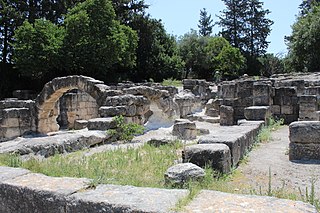
Beit She'arim, also Besara, was a Jewish village located in the southwestern hills of the Lower Galilee, during the Roman period, from the 1st century BCE to the 3rd century CE. At one point, it served as the seat of the Sanhedrin, the Jewish judicial and religious council.
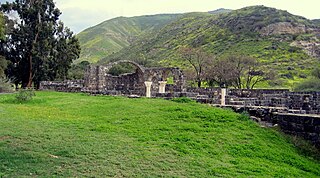
Kursi is an archaeological site in the Golan Heights containing the ruins of a Byzantine monastery and identified by tradition as the site of Jesus' "Miracle of the Swine". Part of the archaeological site is now an Israeli national park. Kursi takes its name from the Talmudic site. A marble slab with Aramaic text discovered in December 2015 seems to indicate that the settlement had, as of c. 500 CE, a Jewish or Judeo-Christian population.

Kfar Baram synagogue, also Kafar Berem synagogue, is the ruins of two ancient Jewish synagogues at the site of Kafr Bir'im, a depopulated Palestinian village which in medieval times was the Jewish village of Kfar Bar'am. Today, it is located in Northern Israel, 3 kilometers from the Lebanese border.

Jish is a local council in Upper Galilee, located on the northeastern slopes of Mount Meron, 13 kilometres (8.1 mi) north of Safed, in Israel's Northern District. In 2022, it had a population of 3,216, which is predominantly Maronite Catholic and Melkite Greek Catholic Christians (63%), with a Sunni Muslim Arab minority.
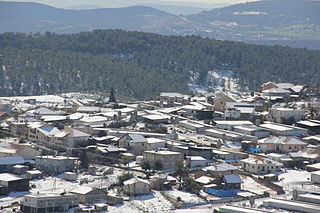
Dalton is a moshav near Safed in northern Israel under the jurisdiction of Merom HaGalil Regional Council. It was founded by immigrants from Tripoli in Libya in 1950 under the leadership of Hapoel HaMizrachi.

Umm el-Qanatir, also spelled Umm el-Kanatir, recent Israeli name Ein Keshatot, is an archaeological site on the Golan Heights, whose main phase is dated to the mid-5th–8th centuries. Excavations have revealed a Roman-period Pagan and later Jewish settlement, who left behind the ruins of a synagogue when they abandoned the town after it being destroyed by the catastrophic 749 earthquake. The site is located 10 kilometres east of the Dead Sea Transform, one kilometre southwest of Natur.
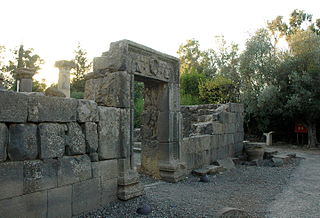
The Katzrin ancient village and synagogue (Hebrew: קצרין העתיקה; also Qasrin, Kasrin, from is an open-air museum located in the Golan Heights on the outskirts of the Israeli settlement of Katzrin. It features the partially reconstructed remains of a village from the 4th-8th century CE, that is: mainly from the Byzantine period, but starting from the Late Roman and extending into the Early Muslim era, or in Jewish historiography, the Talmudic period.

Chorazin or Korazim was an ancient village in the Roman and Byzantine periods, best known from the Christian Gospels. It stood on the Korazim Plateau in the Upper Galilee on a hill above the northern shore of the Sea of Galilee, 2.5 mi (4.0 km) from Capernaum in what is now the territory of modern Israel.
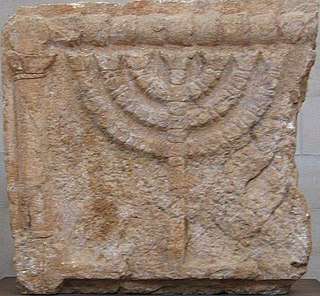
Ancient synagogues in Palestine refers to synagogues and their remains in the Land of Israel/Palestine region, built by the Jewish and Samaritan communities from the time of the Hasmonean dynasty during the Late Hellenistic period, to the Late Byzantine period.

The Sea to Sea Hiking Trail is a long distance hiking trail that crosses the north of Israel, its western end on the coast of the Mediterranean Sea at Achziv National Park near the Lebanese border in the far north of the country, extending eastward to the coast of the Sea of Gallilee near Kibbutz Ginosar, with a total length of about 70 km (43 mi). When hiked from west to east the total elevation gain and loss are about 1.56 km and 1.77 km respectively. The trail is marked with different colors in different sections but is accompanied by purple circles throughout the trail. It takes an average of 3–5 days to complete.

Katzrin is an Israeli settlement organized as a local council in the Golan Heights. Known as the "capital of the Golan", it is the second-largest locality there after Majdal Shams, and the largest Israeli settlement. In 2022 it had a population of 7,876. It is the seat of Golan Regional Council.

Horvat Maon/Horvat Ma'on, Arabic: Khirbet Ma'in or Tell Máîn, is an archaeological site in the Hebron Hills, West Bank, rising 863 metres (2,831 ft) above sea level, where the remains of the ancient town of Ma'on have been excavated. The town, now a ruin, is mentioned in the Book of Joshua and the Books of Samuel. It still had a Jewish population during the Roman and Byzantine periods, and a synagogue was discovered there.

Ein Neshut is an archaeological site where remains of a Jewish settlement from the Talmudic period and an ancient synagogue were discovered in the center of the Golan Heights.

The Deir Aziz synagogue is an ancient synagogue dating from the Mishnaic and Talmudic periods, located at the archeological site of Deir Aziz, in the southern Golan Heights.

Deir Aziz is an ancient Jewish settlement on which a now-abandoned Syrian village was founded in the southern Golan Heights.

Qision was an ancient settlement in Upper Galilee, now an archaeological site in northern Israel, featuring the ruins of the settlement, including a public building, possibly an ancient synagogue, alongside an inscription dedicated to the Roman emperor Septimius Severus and his family commissioned by the local Jewish community.

Kfar Dvora was a Jewish settlement during the Talmudic period in the upper Gilbon River in the Golan Heights. At the site, remains of a Jewish settlement, synagogue, a Beth midrash, 5 inscriptions in Aramaic, 1 in Greek, and one in Hebrew were discovered, which was a novelty in research, as it indicated the existence of a Beth midrash in the place. Many decorated stones were also found, integrated into secondary construction and scattered in the area. On the ruins of Kfar Dvora, the Syrian village of Daburiya was established, which is currently abandoned. Before the Six-Day War, the village was inhabited by Bedouins of the Na'arna tribe, who made secondary use of the stones from the ancient Jewish settlement for construction purposes. The village is currently located northwest of the settlement of kidmat Tzvi.
























